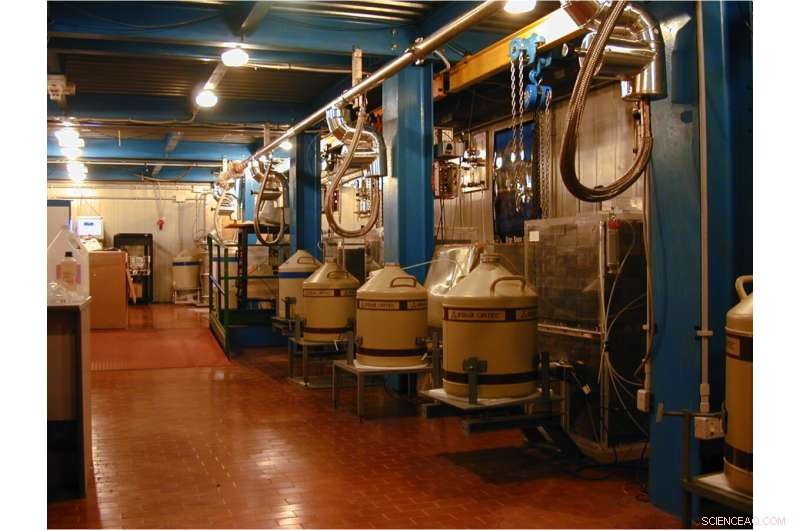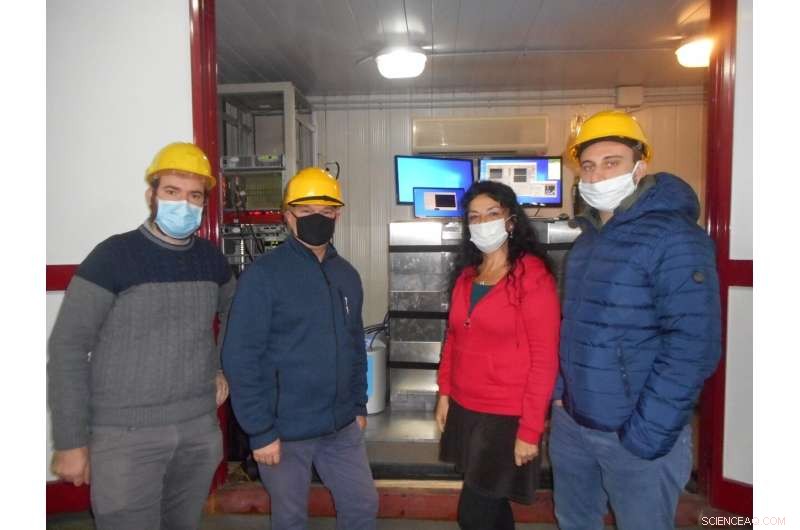
Laboratoriet med låg radioaktivitet i Gran Sasso. Kredit:Massimiliano De Deo, LNGS-INFN
Medvetandets ursprung är ett av vetenskapens största mysterier. En föreslagen lösning, som först föreslogs av Nobelpristagaren och Oxford-matematikern Roger Penrose och narkosläkaren Stuart Hammeroff, vid University of Arizona i Tucson, tillskriver medvetenhet kvantberäkningar i hjärnan. Detta beror i sin tur på föreställningen att gravitation kan spela en roll i hur kvanteffekter försvinner, eller "kollaps". Men en serie experiment i ett labb djupt under Gran Sasso-bergen, i Italien, har misslyckats med att hitta bevis till stöd för en gravitationsrelaterad kvantkollapsmodell, vilket undergräver genomförbarheten av denna förklaring för medvetandet. Resultatet rapporteras i tidskriften Physics of Life Reviews .
"Hur medvetandet uppstår i hjärnan är ett stort pussel", säger Catalina Curceanu, en medlem av fysikens tankesmedja, Foundational Questions Institute, FQXi, och den ledande fysikern på experimenten vid INFN i Frascati, Italien. "Det finns många konkurrerande idéer, men väldigt få kan testas experimentellt."
Kvantfysiken berättar för oss att katter kan vara levande och döda på samma gång, åtminstone i teorin. Men i praktiken ser vi aldrig kattdjur låsta i ett så olyckligt limbotillstånd. En populär förklaring till varför inte är att "vågfunktionen" hos ett system – dess kvantkaraktär som tillåter det att vara i två motstridiga tillstånd samtidigt – är mer benägna att "kollaps" eller förstöras om det är mer massivt och lämnar det i en definierad stat, antingen död eller levande, säg, men inte båda samtidigt. Denna kollapsmodell, relaterad till gravitation som verkar på tunga föremål som katter, åberopades av Penrose och Hammeroff när de utvecklade deras modell för medvetande, 'Orch OR theory' (the Orchestrated Objective Reduction theory), på 1990-talet.
Kvantberäkningar i hjärnan
Curceanu blev först intresserad av Orch OR-teori när hon träffade Penrose, också en FQXi-medlem, på en konferens för några år sedan. Medvetande förknippas vanligtvis inte med kvantegenskaper eftersom kvanteffekter är ömtåliga och svåra att upprätthålla även under mycket kontrollerade förhållanden och kalla temperaturer i labbet. Så det hade länge antagits att hjärnans varma och våta miljö skulle vara för störande för att tillåta kvanteffekter att överleva. Men Penrose förklarade att han och Hammeroff har identifierat små strukturer som kallas mikrotubuli i neuroner i hjärnan som potentiellt kan upprätthålla kvanteffekter under korta perioder - precis tillräckligt länge för att utföra kvantberäkningar. Orch OR-teorin tillskriver medvetenhet till kvantberäkningar orkestrerade ("Orch") av elektriska svängningar i dessa mikrotubuli. "Vad jag älskade med den här teorin var att den i princip är testbar och jag bestämde mig för att söka efter bevis som kan hjälpa till att bekräfta eller förfalska den", säger Curceanu.
"Vad jag älskade med den här teorin var att den i princip är testbar och jag bestämde mig för att söka efter bevis som kan hjälpa till att bekräfta eller förfalska den."
Kärnan i teorin är tanken att gravitation är relaterad till kvantvågfunktionskollaps och att denna kollaps är snabbare i system med mer massa. Detta koncept utvecklades i ett antal modeller av olika fysiker på 1980-talet. One of those was Lajos Diósi, at the Wigner Research Center for Physics and at the Eötvös Loránd University in Budapest, Hungary, who has co-authored the new paper with Curceanu, Maaneli Derakhshani of Rutgers University in New Brunswick, New Jersey, Matthias Laubenstein also at INFN, and Kristian Piscicchia of CREF and INFN. Penrose independently approached this idea a few years later and it became the core of his consciousness theory with Hammeroff.
The two theories are often referred to by the umbrella term, the "Diósi-Penrose theory." But behind the joint name there is an important difference, notes Curceanu. Diósi's approach predicts that collapse would be accompanied by the spontaneous emission of a small amount of radiation, just large enough to be detected by cutting edge experiments.

Left to right:Fabrizio Napolitano, Alberto Clozza, Catalina Curceanu, Marco Miliucci -- all from INFN-LNF. Credit:Catalina Curceanu
Going underground
Curceanu's underground lab is housed within the Gran Sasso National Laboratory, 1.4 km under the Gran Sasso Italian mountains. The lab stands on one side of the 10-km long highway tunnel which crosses the Gran Sasso massif, connecting L'Aquila and Teramo. "The location was chosen because it is basically free from cosmic-ray radiation sources above the ground, that could interfere with the experiment," says Curceanu. The experiment uses an extremely sensitive cylindrical detector, not much bigger than a mug, made from highly pure germanium. It is surrounded by shielding, made of layers of ultra-pure lead and copper, to shelter it from any background radiation coming from the rocks. After running the experiment for two months the team did not measure spontaneous radiation signals, constraining the feasibility of gravity-related collapse. In 2020, the team reported in Nature Physics that their negative result had helped them rule out the simplest version of the Diósi-Penrose model.
In their new paper they have explicitly examined the repercussions of their finding for Penrose and Hammeroff's Orch OR theory of consciousness. After reanalyzing the most plausible scenarios set out by Hammeroff and Penrose, in light of their recent experimental constraints on quantum collapse, they were led to conclude that almost none of the scenarios are plausible. "This is the first experimental investigation of the gravity-related quantum collapse pillar of the Orch OR consciousness model, which we hope will be followed by many others," says Curceanu. "I am very proud of our achievement."
Interdisciplinary characteristics
The experiments and analysis are partially funded by a grant from the Foundational Questions Institute, FQXi. "Without it, it would have not been possible to achieve this outcome," says Curceanu. "It is hard to otherwise get funding for projects such as this, based on its interdisciplinary characteristics."
"It is really exciting to connect what you can do in the laboratory to perhaps the biggest mystery in the universe—consciousness."
But all is not lost for Orch Or, adds Curceanu. "Actually, the real work is just at the beginning." she says. In fact, Penrose's original collapse model, unlike Diósi's, did not predict spontaneous radiation, so has not been ruled out. The new paper also briefly discusses how a gravity-related collapse model might realistically be modified. "Such a revised model, which we are working on within the FQXi financed project, could leave the door open for Orch OR theory," Curceanu says.
Meanwhile the team is preparing to test these refined new collapse models, to further investigate their implications for the Orch OR model. "It is really exciting to connect what you can do in the laboratory to perhaps the biggest mystery in the universe—consciousness," says Curceanu. + Utforska vidare